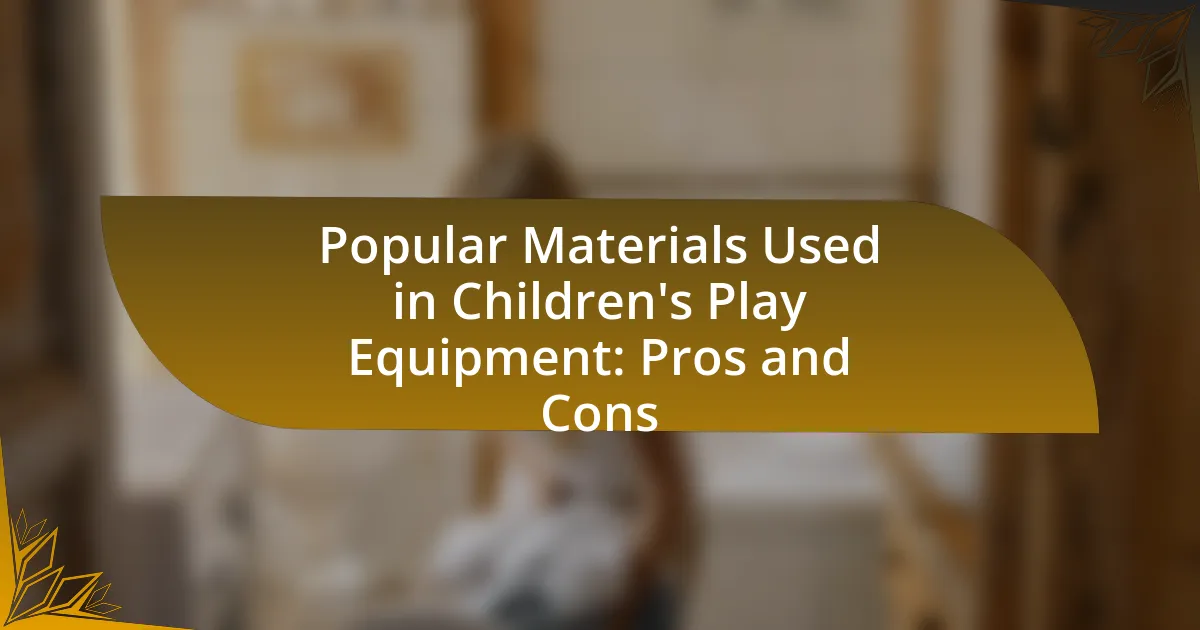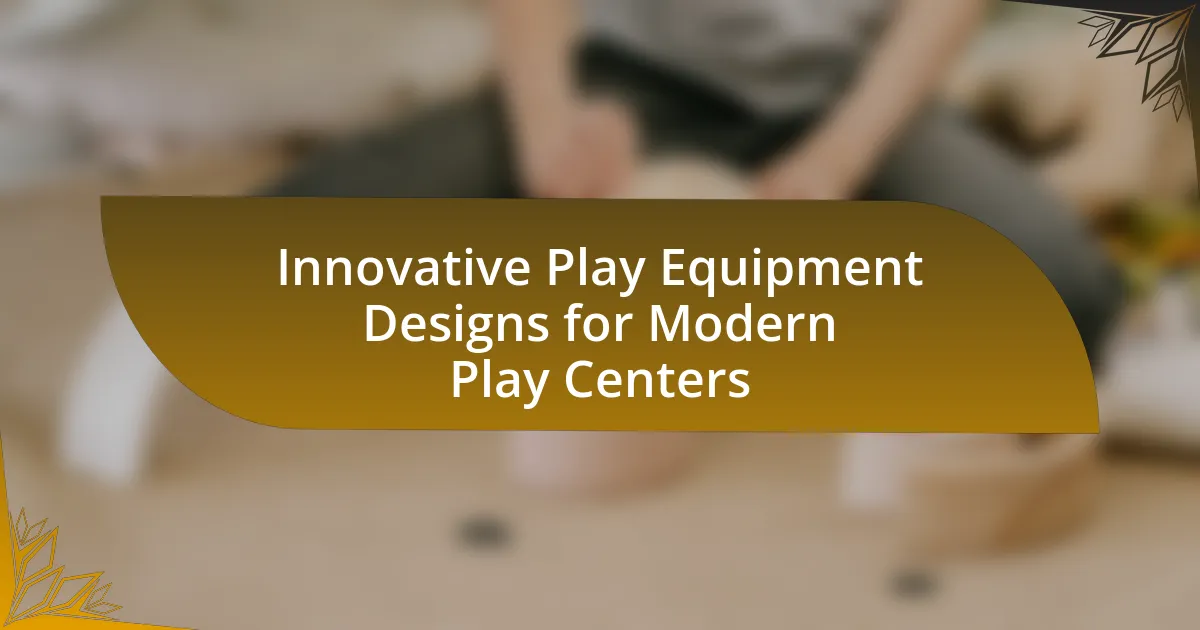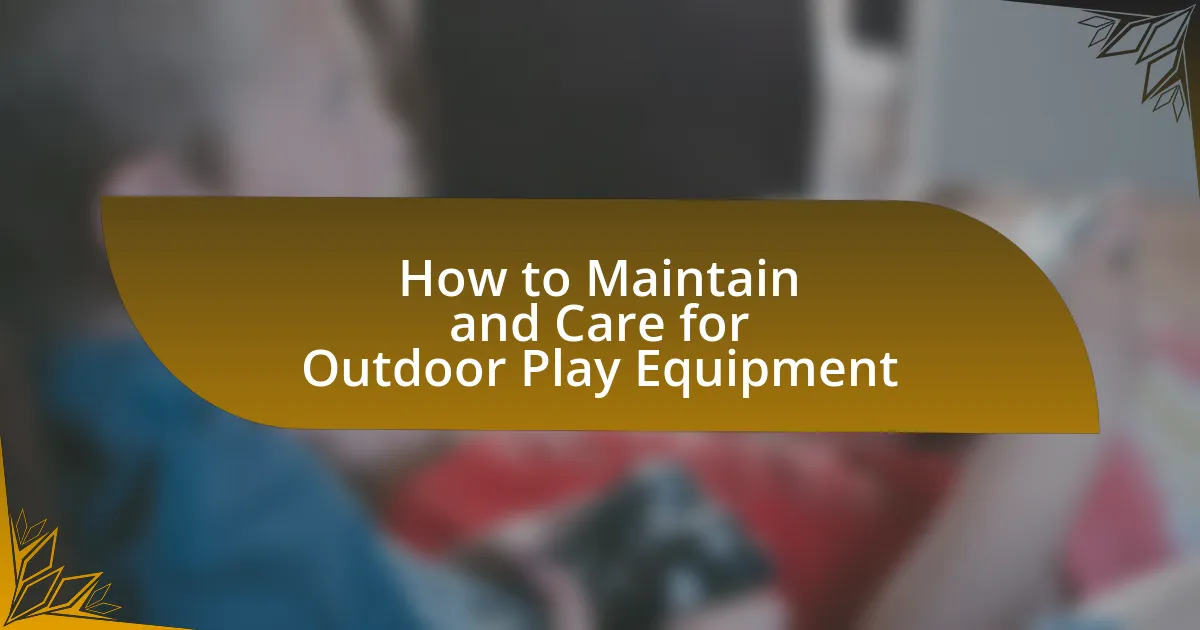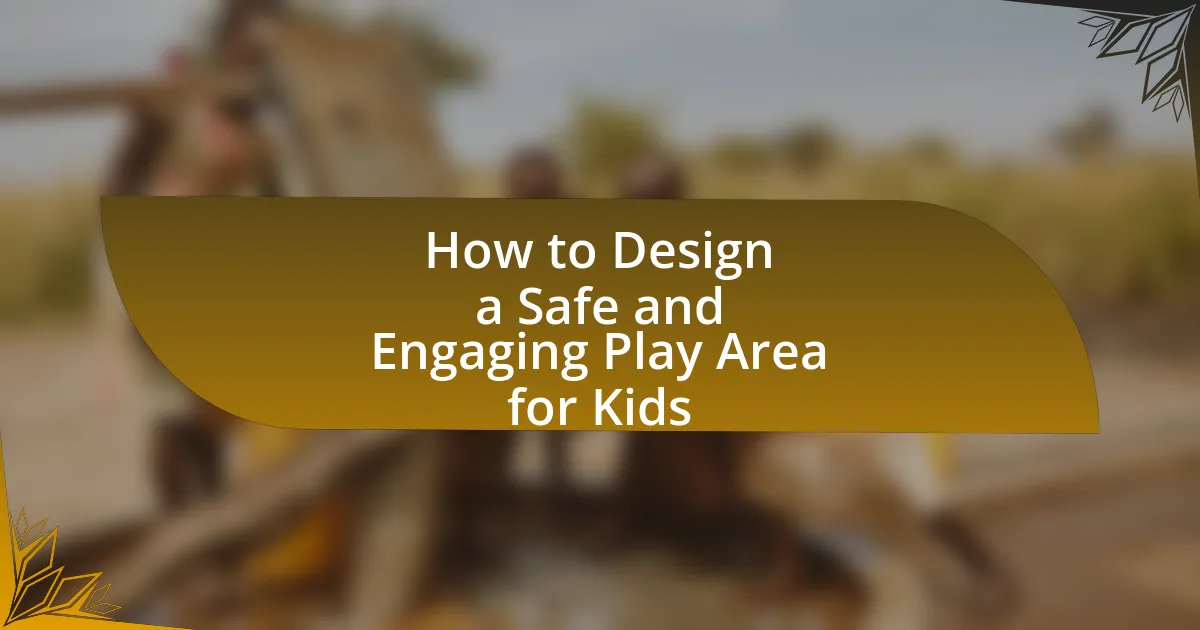Selecting play equipment that encourages physical activity is essential for promoting movement, exercise, and active play among children. The article outlines the importance of physical activity for children’s health, cognitive development, and social skills, emphasizing that access to diverse play equipment can significantly enhance engagement in physical activities. Key factors in selecting appropriate play equipment include safety, age appropriateness, durability, and accessibility, all of which contribute to fostering an active lifestyle. Additionally, the article discusses the characteristics of effective play equipment, maintenance practices, and strategies to create engaging play environments that maximize the benefits of physical activity for children.

What is Selecting Play Equipment that Encourages Physical Activity?
Selecting play equipment that encourages physical activity involves choosing items designed to promote movement, exercise, and active play among children. This selection process is crucial because research indicates that active play contributes to children’s physical health, social skills, and cognitive development. For instance, equipment such as climbing structures, swings, and interactive games can significantly increase children’s engagement in physical activity, leading to improved fitness levels and reduced obesity rates. Studies have shown that children who have access to diverse play equipment are more likely to meet recommended physical activity guidelines, highlighting the importance of thoughtful selection in fostering an active lifestyle.
Why is physical activity important for children?
Physical activity is important for children because it promotes healthy growth and development. Engaging in regular physical activity helps children build strong bones and muscles, improves cardiovascular fitness, and supports a healthy weight. According to the Centers for Disease Control and Prevention, children should engage in at least 60 minutes of physical activity each day to achieve these health benefits. Additionally, physical activity enhances cognitive function, improves mood, and fosters social skills through teamwork and cooperation in play.
What are the health benefits of physical activity for children?
Physical activity provides numerous health benefits for children, including improved cardiovascular fitness, stronger muscles and bones, and enhanced mental health. Engaging in regular physical activity helps children maintain a healthy weight, reducing the risk of obesity, which affects approximately 19.3% of children and adolescents in the United States according to the CDC. Additionally, physical activity promotes better sleep patterns and boosts self-esteem, contributing to overall emotional well-being. Research published in the Journal of Pediatrics indicates that active children are less likely to experience anxiety and depression, highlighting the mental health advantages of physical activity.
How does physical activity impact children’s development?
Physical activity significantly enhances children’s development by promoting physical health, cognitive function, and social skills. Engaging in regular exercise helps children build strong muscles and bones, maintain a healthy weight, and reduce the risk of chronic diseases. Research indicates that children who participate in physical activities demonstrate improved concentration, memory, and classroom behavior, as noted in a study published in the Journal of Pediatrics by D.H. Ginsburg, which highlights the correlation between physical activity and cognitive performance. Additionally, physical activity fosters social interaction and teamwork, essential for developing communication skills and emotional intelligence, as evidenced by findings from the American Academy of Pediatrics.
What types of play equipment promote physical activity?
Play equipment that promotes physical activity includes climbing structures, swings, slides, and interactive games. Climbing structures encourage children to engage in strength-building activities and improve coordination, while swings enhance balance and core strength. Slides provide opportunities for climbing and descending, fostering gross motor skills. Interactive games, such as those that require running or jumping, further stimulate cardiovascular fitness. Research indicates that children who engage with such equipment are more likely to meet recommended physical activity levels, supporting overall health and development.
What are the characteristics of effective play equipment?
Effective play equipment is designed to promote physical activity, safety, and developmental benefits for children. Key characteristics include durability, ensuring that materials can withstand frequent use and various weather conditions; safety features, such as rounded edges and non-toxic materials to minimize injury risks; and age-appropriateness, allowing children of different developmental stages to engage safely and effectively. Additionally, effective play equipment encourages creativity and social interaction, fostering cooperative play and imaginative scenarios. Research indicates that equipment designed with these characteristics can significantly enhance children’s physical activity levels, contributing to overall health and well-being.
How do different types of equipment cater to various age groups?
Different types of equipment cater to various age groups by being designed with specific developmental needs and safety considerations in mind. For instance, playground equipment for toddlers often includes lower platforms, soft surfaces, and smaller climbing structures to ensure safety and encourage exploration, while equipment for older children may feature higher slides, more complex climbing structures, and interactive elements that promote physical challenges and social interaction. Research indicates that age-appropriate equipment not only enhances physical activity but also supports cognitive and social development, as seen in studies conducted by the American Academy of Pediatrics, which emphasize the importance of tailored play environments for different age groups.

How do you select the right play equipment for encouraging physical activity?
To select the right play equipment for encouraging physical activity, prioritize equipment that promotes active engagement and movement. Research indicates that equipment such as climbing structures, swings, and slides effectively enhance children’s physical activity levels by providing opportunities for climbing, swinging, and sliding, which are essential for developing motor skills and strength. Additionally, consider the age appropriateness and safety standards of the equipment, as these factors significantly influence children’s willingness to engage in physical play. Studies show that well-designed play environments can increase physical activity by up to 25%, highlighting the importance of selecting equipment that is not only fun but also safe and suitable for the intended age group.
What factors should be considered when selecting play equipment?
When selecting play equipment, safety, age appropriateness, durability, and accessibility are critical factors. Safety ensures that the equipment meets safety standards to prevent injuries; for instance, equipment should have rounded edges and be made from non-toxic materials. Age appropriateness guarantees that the equipment is suitable for the developmental stages of children, as different age groups require different types of challenges and engagement. Durability is essential to withstand weather conditions and heavy use, which can be verified through manufacturer specifications and warranties. Accessibility ensures that all children, including those with disabilities, can use the equipment, promoting inclusivity in play environments.
How does safety influence the selection of play equipment?
Safety significantly influences the selection of play equipment by prioritizing the protection of children during play. Manufacturers and educators assess equipment based on safety standards, such as ASTM and CPSC guidelines, which dictate design, materials, and installation to minimize risks of injury. For instance, equipment with rounded edges, non-toxic materials, and appropriate fall zones reduces hazards. Research indicates that safe play environments lead to increased physical activity, as children are more likely to engage in play when they feel secure. Therefore, safety considerations directly impact the types of equipment chosen, ensuring they promote active play while minimizing injury risks.
What role does space availability play in equipment selection?
Space availability is crucial in equipment selection as it determines the type and size of equipment that can be accommodated in a given area. Limited space may restrict the use of larger or more complex equipment, while ample space allows for a wider variety of options, promoting diverse physical activities. For instance, research indicates that playgrounds with adequate space can support multiple play structures, which enhances children’s physical engagement and social interaction, ultimately fostering a more active lifestyle.
How can you assess the quality of play equipment?
To assess the quality of play equipment, evaluate its safety, durability, and suitability for the intended age group. Safety can be assessed by checking for compliance with safety standards such as ASTM F1487, which outlines guidelines for playground equipment. Durability is determined by the materials used; for instance, metal and high-density polyethylene are known for their longevity. Suitability involves ensuring that the equipment is designed for the specific age range, as equipment for younger children should have lower heights and softer surfaces to prevent injuries. These criteria ensure that the play equipment is safe, long-lasting, and appropriate for children’s developmental needs.
What standards should play equipment meet for safety and durability?
Play equipment should meet the ASTM F1487 standard for safety and durability, which outlines performance requirements for playground equipment to minimize hazards. This standard includes guidelines for materials, structural integrity, and impact-absorbing surfaces to ensure user safety. Additionally, compliance with the Consumer Product Safety Commission (CPSC) guidelines is essential, as these provide recommendations for safe design and installation practices. Adhering to these standards helps prevent injuries and ensures that the equipment can withstand various weather conditions and heavy usage, thereby enhancing its durability.
How can user reviews and ratings inform your selection?
User reviews and ratings can significantly inform your selection of play equipment by providing insights into the experiences of other users. These reviews often highlight the effectiveness, durability, and safety of the equipment, which are crucial factors for encouraging physical activity. For instance, a study published in the Journal of Consumer Research found that products with higher ratings are perceived as more reliable and are more likely to be purchased. Additionally, user feedback can reveal specific features that enhance play value, such as age appropriateness and ease of assembly, which can guide your decision-making process.

What are the best practices for implementing play equipment that encourages physical activity?
The best practices for implementing play equipment that encourages physical activity include selecting equipment that promotes diverse movement patterns, ensuring safety and accessibility, and incorporating features that engage children of various ages and abilities. Equipment such as climbing structures, slides, and swings should be designed to facilitate physical challenges, enhancing strength, coordination, and balance. Research indicates that inclusive play environments, which accommodate children with disabilities, can increase overall participation and physical activity levels (Frost, J. L., & Klein, A. M., 2012, “Play and Child Development”). Additionally, providing shaded areas and seating encourages longer play sessions, further promoting active engagement.
How can you create an engaging play environment?
To create an engaging play environment, incorporate diverse and interactive play equipment that promotes physical activity. Research indicates that environments featuring climbing structures, slides, and balance beams significantly enhance children’s physical engagement and social interaction. For instance, a study by the American Academy of Pediatrics found that children who play in well-designed playgrounds exhibit increased levels of physical activity, leading to improved health outcomes. Additionally, including elements like open spaces for running and areas for group games fosters creativity and collaboration among children, making the play environment more stimulating and enjoyable.
What strategies can be used to encourage children to use the equipment?
To encourage children to use the equipment, implementing engaging and interactive play sessions is essential. Structured activities that incorporate the equipment can spark interest and motivate children to participate. For instance, organizing games that require the use of specific equipment, such as obstacle courses or team challenges, can enhance their enjoyment and willingness to engage. Research indicates that children are more likely to use play equipment when it is presented in a fun and social context, as highlighted in a study by the American Academy of Pediatrics, which emphasizes the importance of active play in promoting physical activity among children.
How can you incorporate educational elements into play equipment?
Incorporating educational elements into play equipment can be achieved by integrating features that promote learning through interaction. For example, play structures can include panels with numbers, letters, or shapes that children can engage with while climbing or playing. Research indicates that interactive play equipment enhances cognitive development; a study by the American Academy of Pediatrics highlights that play environments that stimulate problem-solving and creativity contribute to children’s learning outcomes. Additionally, incorporating sensory elements, such as textures or sounds, can facilitate exploration and sensory learning, further enriching the educational experience during play.
What maintenance practices are essential for play equipment?
Essential maintenance practices for play equipment include regular inspections, cleaning, and repairs. Regular inspections should occur at least monthly to identify wear and tear, loose parts, or safety hazards. Cleaning involves removing debris, dirt, and any hazardous materials to ensure a safe play environment. Repairs must be conducted promptly to fix any identified issues, such as replacing broken components or tightening loose fittings. According to the U.S. Consumer Product Safety Commission, maintaining play equipment can significantly reduce the risk of injuries, emphasizing the importance of these practices for safety and longevity.
How often should play equipment be inspected for safety?
Play equipment should be inspected for safety at least once a month. Regular inspections help identify wear and tear, potential hazards, and ensure compliance with safety standards. According to the U.S. Consumer Product Safety Commission, frequent inspections are essential to maintain a safe play environment and reduce the risk of injuries.
What are common issues to look for during maintenance checks?
Common issues to look for during maintenance checks of play equipment include structural integrity, wear and tear, and safety hazards. Structural integrity involves checking for loose bolts, cracks, or rust that could compromise the equipment’s stability. Wear and tear can manifest as frayed ropes, worn-out surfaces, or faded paint, indicating the need for repairs or replacements. Safety hazards include sharp edges, protruding nails, or unstable footing that could pose risks to users. Regular inspections help ensure that play equipment remains safe and functional, thereby promoting physical activity among children.
What tips can help maximize the benefits of play equipment for physical activity?
To maximize the benefits of play equipment for physical activity, ensure that the equipment is age-appropriate and encourages diverse movements. Age-appropriate equipment, such as climbing structures for older children and balance beams for younger ones, promotes safe and effective physical engagement. Additionally, incorporating a variety of equipment types, such as swings, slides, and interactive play panels, can stimulate different muscle groups and enhance overall physical development. Research indicates that children who engage in varied physical activities are more likely to develop motor skills and maintain a healthy weight. Therefore, selecting equipment that encourages exploration and creativity can significantly enhance physical activity levels among children.







































